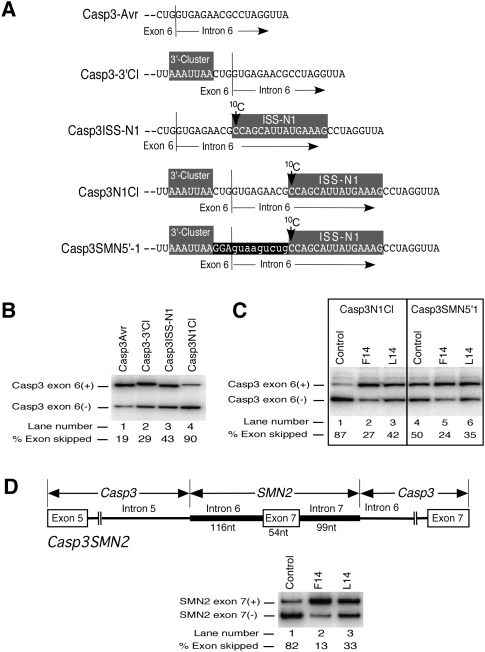FIGURE 5.
Effect of the heterologous context on antisense response of ISS-N1-targeting ASOs. (A) Diagrammatic representation of exon 6/intron 6 junction in Casp3 minigene variants. 3′-Cluster and ISS-N1, which are shaded in gray, were inserted either individually or together 3 nt upstream of and 9 nt downstream from the exon/intron junction, respectively. In Casp3-SMN5′-1 minigene, the entire region from the beginning of 3′-Cluster to the end of ISS-N1 corresponds to SMN sequence. The last 3 nt of SMN exon 7 and the first 9 nt of SMN intron 7 are highlighted in black. As a result of this insertion, Casp3 exon 6 now has the 5′ ss of SMN exon 7 followed by ISS-N1 element. The location of 10C is marked by an arrow. (B) Effect of 3′-Cluster and ISS-N1 insertions on Casp3 exon 6 splicing. HeLa cells were transfected with 0.8 μg of Casp3 minigene variant, and the total RNA for in vivo splicing assay was isolated 24 h post-transfection. Exon 6-included and exon 6-skipped spliced products are indicated. Percentage of exon skipping was calculated from the total value of exon-included and exon-skipped products similarly as in Figure 2. (C) In vivo splicing patterns of two Casp3 minigene variants in the presence of ASOs. Cotransfections and splicing analysis were done as in Figure 2A. (D) In vivo splicing patterns of Casp3SMN2 minigene in the presence of ASOs. Diagram explaining the composition of this hybrid minigene is shown on the top. Cotransfections and splicing analysis were done as in panel C.

